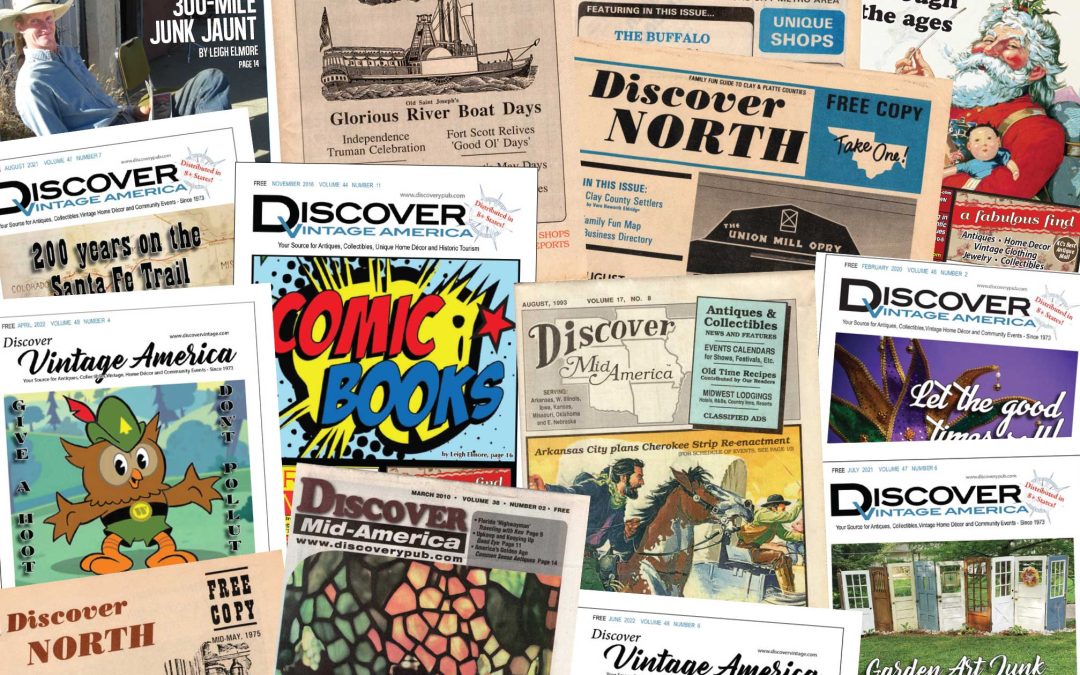August 2023
Cover Story
Fifty years of ‘Discovering’ began with a modest ‘guide’
by Ken Weyand
But the “insurance executive” failed to materialize. According to my business partner, his plane had crashed on the way to Kansas City, but that story never checked out. My business partner and I parted ways. Other alternatives were discussed, but I eventually found myself on my own.
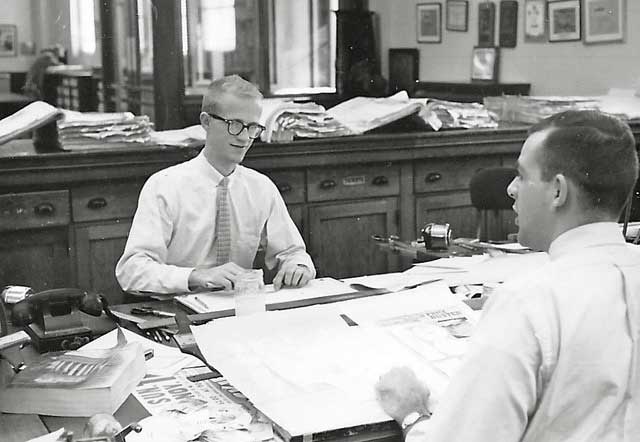
Ken Weyand at The Kansas City Start
Part of my partnership involved helping Murrel produce his weekly (along with another paper in Leavenworth County that he had a relationship with) as well as working to make our mutual Platte County project succeed. To enhance our paper, I hit upon the idea of a “history insert” that could be picked up from store counters, but would also be used as an insert, and serve as a bonus for subscribers. Williams would help with the editorial content, as would other writers, including Vera Haworth Eldridge, a Liberty resident who contributed many history pieces about both counties over the years.
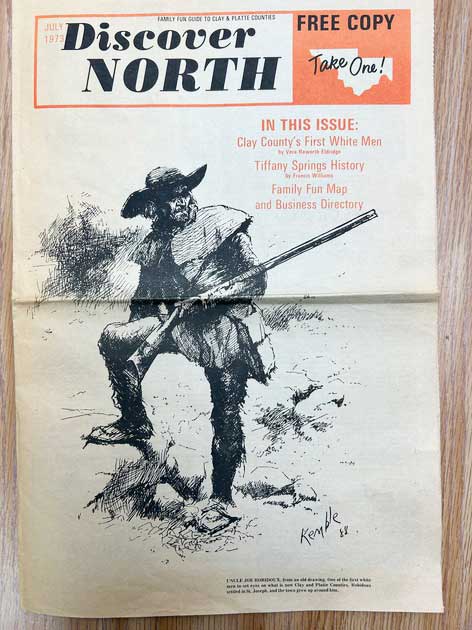
Discover NORTH
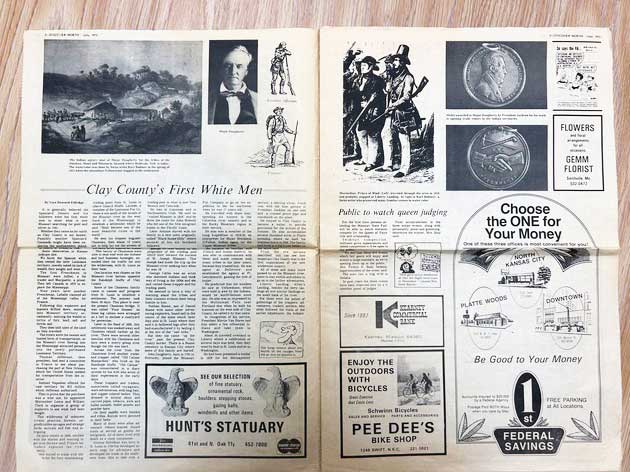
The first edition of Discover North
For a time, everything went well, with Discover North developing into a productive part of our publishing efforts. But the weekly “Views” failed to prosper, and Murrel and I eventually went our separate ways. It was an amicable split, with Murrel publishing a version of “Discover North” as a historical supplement to his Kansas paper. After a couple of years, my version continued on its own, adding pages here and there, and new advertisers, many of whom became faithful backers of the little publication, known to most as just “Discover.”
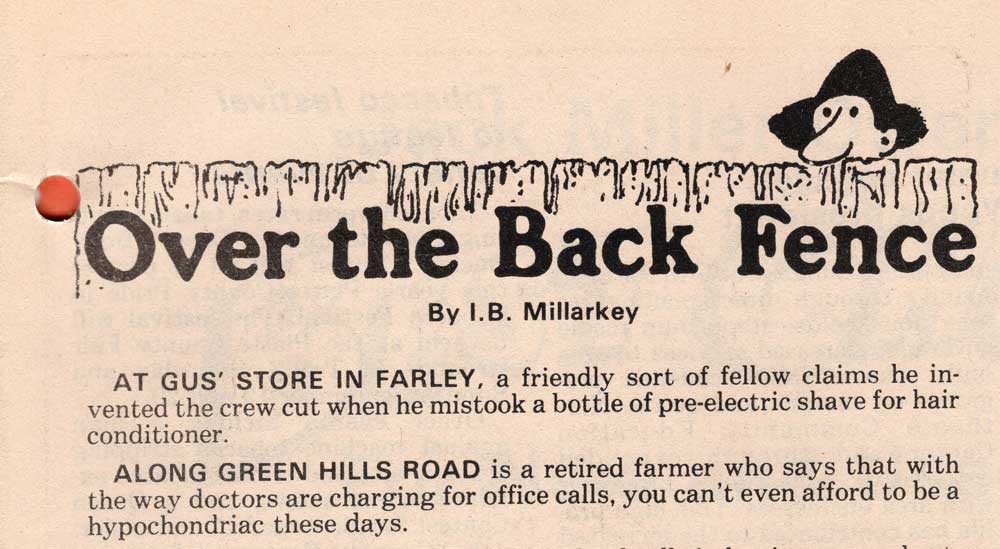
I. B. Millarkey’s column
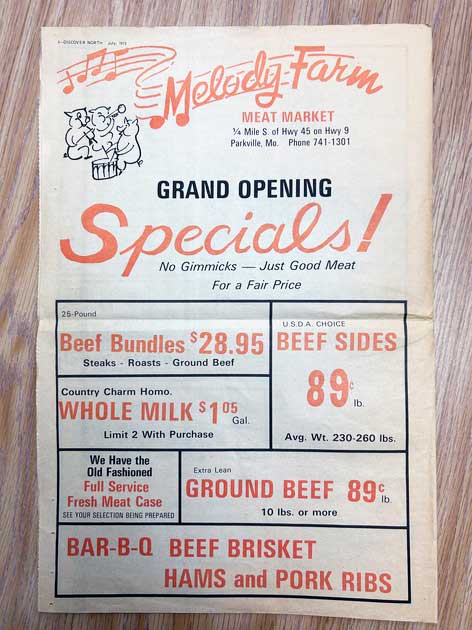
Meat prices in 1973
One of the regular columns was a humor piece titled “Over the Back Fence.” Its author was “I.B.Millarkey,” ghost-written by Francis Williams. Loaded with country humor, it was full of satire and tongue-in-cheek witticisms. Occasionally it prompted editorial letters, some of which took offense at the writer’s opinions, apparently unaware that “I.B. Millarkey” was a pseudonym.
Over the years, the paper experimented with different editorial approaches, including a recipe section, featuring contributed material. Those who submitted published recipes would get a free subscription. This became complicated when a resident of Australia submitted an outback recipe, having received the paper from a pilot with Qantas Airlines. I remember that recipe called for a very expensive subscription.
Two books were printed, combining contributed recipes with local history. Both were published under the heading, “The Woodsmoke Series,” and were titled “Recipes & Stories of Early-Day Settlers.” The first was published in 1988. The second book consisted of stories relating to settlers’ “Steamboat Adventures,” and was published in 1991. Both books sold well, and also were used as subscription incentives.
For several years, Betty Soper, long-time president of the Platte County Historical Society, published a column, “Genealogy Queries,” answering questions about ancestry issues. The Society’s offices also have been a long-time repository of back issues of Discover North.
During the paper’s first decade, it became apparent that antique and collectible shops and malls were among its most enthusiastic supporters. Rather than being competitive with other businesses, antique shops found they could prosper by supporting each other, and promoting their town as an “antiquing destination.” As a result, the paper was able to grow, adding advertisers in small towns outside the original Clay-Platte market area.
The first expansion took the paper south of the Missouri River and into Kansas City and Independence. Other areas quickly followed. Eventually, separate editions extended the paper’s reach into surrounding states. The idea of multiple editions eventually was abandoned due to printing complexity, and by the early 2000s the new Discover Mid-America had reached readers in nine Midwestern states.
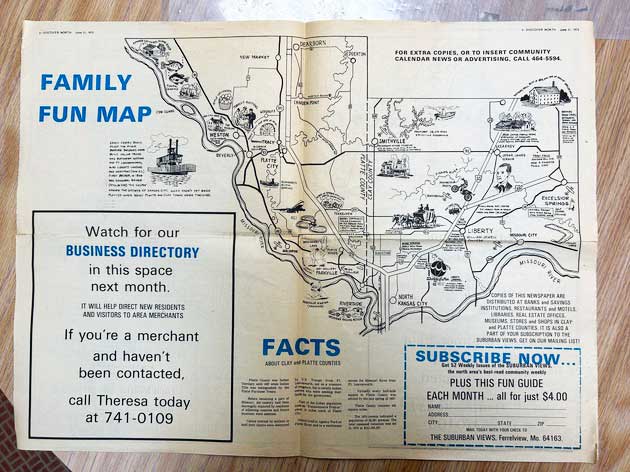
“Family Fun Map”
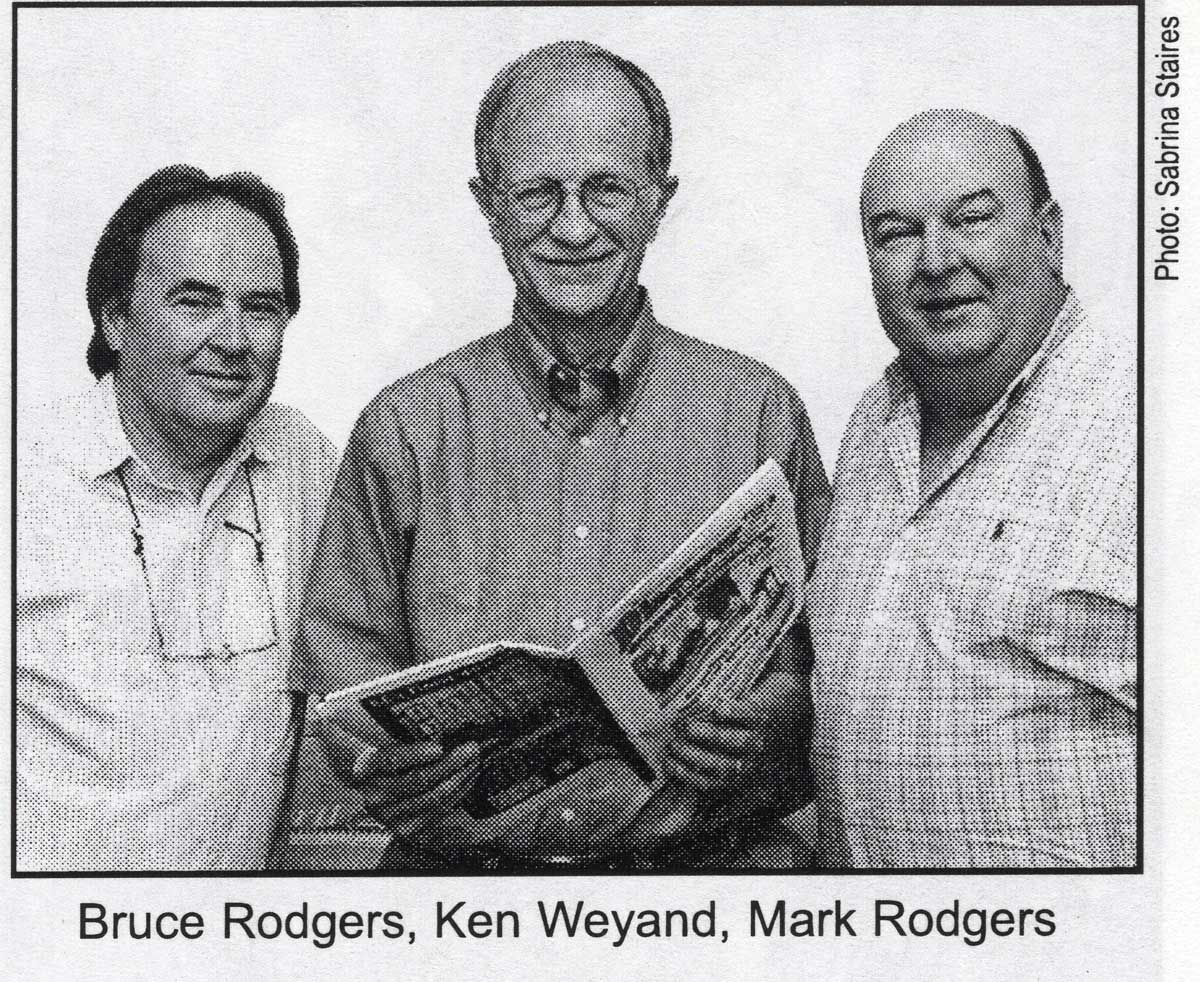
Bruce Rodgers, Ken Weyand, and Mark Rodgers
Not long after Bruce took over the publishing duties, I retired, but continued to write a column for the paper. The “writing bug” continues to bite, and I’ve been contributing a column, “Vintage Discoveries,” based on family treasures and their history, ever since.
Today, Discover Vintage America is owned and published by Patti Klinge, who also composes the paper, prepares it for publication, and wears several other hats. Corbin Crable, a former professor of journalism at Johnson County Community College is the editor. Advertising is sold and managed by Al Hedrick, who first became part of the Discover team in the mid-’90s. I’m proud of their work and happy to see how far my little “tourist guide” has progressed over 50 years
Contact Ken Weyand at kweyand1@kc.rr.com.
A half century of ‘Discover Vintage America’
by Leigh Elmore
Hats off to my former employer Discover Vintage America for navigating the treacherous waters of modern publishing and carving out such an enduring niche in a market that keeps on surprising with its resiliency.
I am forever grateful to former publisher Bruce Rodgers for giving me the opportunity to serve as editor of Discover from 2012 to 2020. Bruce knew I harbored a “history gene” and that I wouldn’t really be able to pass up the chance. And this old dog learned a lot from him, even on the back slope of my journalism career. Bruce had that gruff exterior and liked to bark on the phone sometimes. But he has that proverbial “soft heart” and was generous to the ones he respected and loved. There are a couple of cats in Florida living better lives these days because of Bruce Rodgers.
But, coming into the Discover Vintage America family introduced me to its founder, Ken Weyand, who was writing a monthly regional travel column at the time.
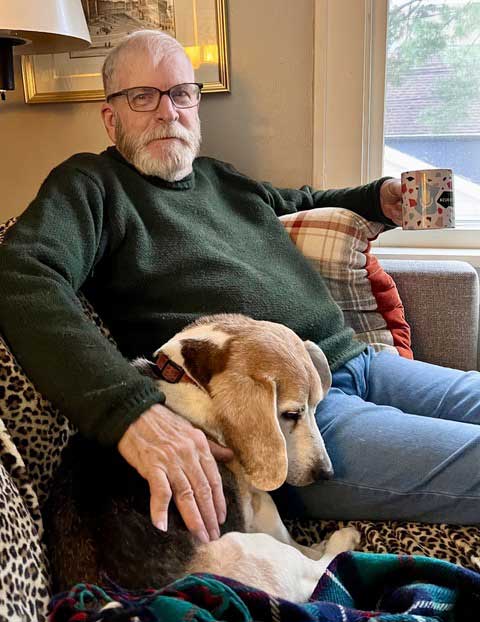
Leigh Elmore, editor 2012-2020
By way of example, my wife, Lorraine, started working for Hallmark Cards in 1984 as a photo stylist. One of her responsibilities was “propping,” that is, going to stores, especially antique shops, and renting items to use as props in photo shoots. Shop owners loved this. Her mentor, Carol Hale, put a copy of Discover in her hands and told her “This is the bible for antiques in the Midwest.”
Discover’s columnists remain faithful and offer insights into many aspects of collecting antiques. Peggy Whiteneck’s common-sense approach to collecting and marketing in “Good Eye” is always illuminating and full of good ol’ New England practicality. Sandra Starley knows more about quilting and its history than anybody I know, and her monthly “Covering Quilts” column proves that. And the venerable Anne Gilbert offered up her knowledge of the trade right up to her death at age 96 in June.
Best wishes to Patti Klinge, who took over ownership of Discover just as I was retiring in 2020 and has a vision for the future. Editor Corbin Crable is adept at identifying where antiquing is headed. Al Hedrick and Melissa Lambert will soon be calling to reserve your ad space in the next issue.
Keep on keepin’ on Discover Vintage America!
Leigh Elmore served aseditor of Discover Vintage America from 2012 to 2020.
Thank you from the bottom of my heart
by Patti Klinge
I’m not saying that Bruce has big feet, just that he had a lot on his plate as owner and publisher of Discover Vintage America. I know even more now how true that is. This probably sounds corny, but I know my angels were guiding me when I landed in the art director’s chair at the Discover Vintage America office in North Kansas City 10 years ago.
After 25 years in IT, as a software programmer, tester, and project manager, I left the corporate world and returned to school to learn graphic design, which combined a love of art with my computer skills. Midway through the program, when looking for a summer job, Bruce convinced me to come work for him on Discover, but not just for the summer. I guess it was a good fit because here I still am!
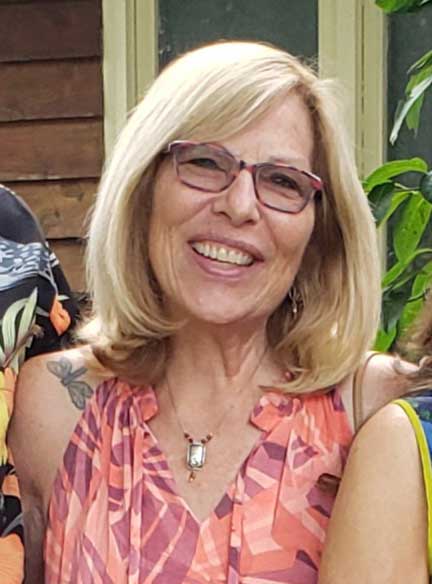
Patti Klinge
I love Discover Vintage America. I love the history of the magazine and the fact that the publication is quite vintage itself, having been around for 50 years now.
I think Discover serves an important purpose, bringing people together – merchants and shoppers hunting for treasures, communities celebrating traditions, and travelers enjoying festivals and exploring new places.
Together with editor Corbin Crable, I endeavor to continue the tradition of Discover Vintage America for years to come, until I pass the baton on again.
Thank you to Ken Weyand, Bruce Rodgers, Leigh Elmore, Al Hedrick, Corbin Crable, and all the other designers, sales reps, and editors over the past 50 years whose love and dedication have kept the paper going and the dream alive.
Also, a big thank you to our fabulous printer, Breese Printing & Publishing in Breese, IL, and Jason Green and his local delivery team at Publishers Delivery Solutions in Lenexa, KS.
And especially thank you to our loyal advertisers and readers, without whom we would not exist.
Contact Patti Klinge at publisher@discovervintage.com.
A long, strange trip (At least, for me)
by Bruce Rodgers
When I bought the publication in January 2001, people didn’t really text. The phone worked fine or, if not, just show up in person. By the time I left 17 years later, Discover had kept up with the time — Facebook, an improved website and, I imagine, a whole lot more texting. The only thing missing is an “antique” license plate like they hang on automobiles, except they do that after 25 years.
I’m not surprised Discover has 50 years under its belt. It performed a service and still does. The marriage of a small businessperson and a love of antiques needs a big voice. Discovery Publications (now Discover Vintage Revival) through Discover Vintage America does that.
Life moves on. Things get old, things get better. There’s always a champion of this or that. I’m not sure how much I did to keep it going, but I’m proud to have been a part of it. My congratulations to Patti Klinge and the rest of the staff. Sometimes, old things don’t get old.
Bruce Rodgers publisher, 2001-2018
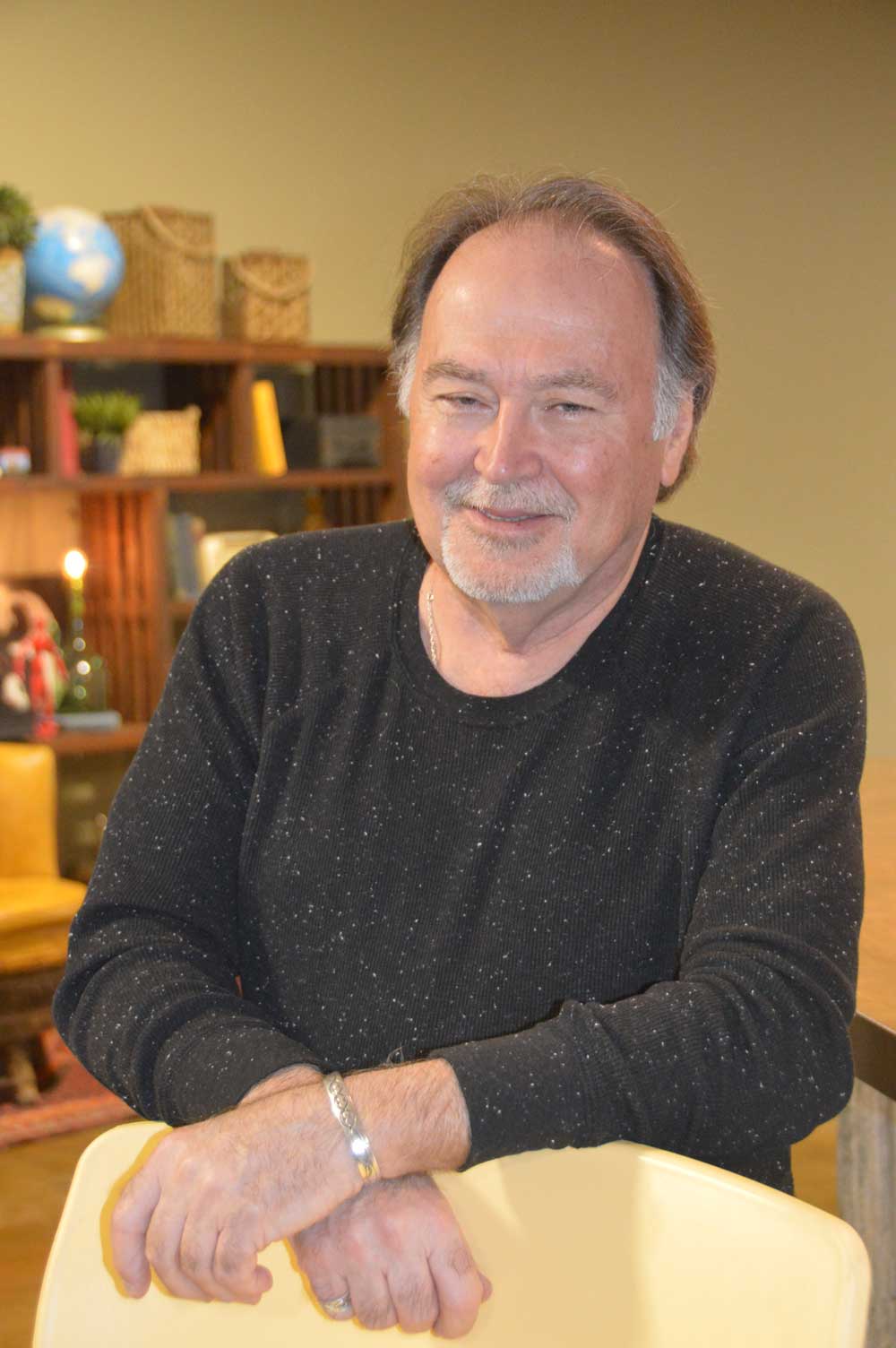
Bruce Rodgers
Al Hedrick: The man, the myth, the legend…
by Patti Klinge
The “Voice” of Discover Vintage America
Over the past 27 years, he has become the “voice” of Discover Vintage America and an important member of the team. As the senior advertising account representative, most people calling to advertise have spoken with Al Hedrick on the telephone at least once. His comforting voice evokes confidence that running an ad in Discover will bring shoppers to stores and visitors to events. He takes an interest in his clients and remembers to ask about the kids… that’s just the kind of guy he is.
Al joined the Discover team in 1996 when he was closing his design business and wanted to sell the computers and other office equipment he no longer needed. Ken Weyand, then owner and publisher of Discover, took him up on the offer and then asked if he might want to try his hand at selling ads for the publication. Obviously, that worked out well. He may be a little old-fashioned in his approach, but he has his own style of selling and it seems to work for him.
Now that he’s getting on in years, the days of road trips to neighboring states to sell ads are over, but he remembers fondly the past trips to Omaha, St. Joseph, Wichita, Weston, Ottawa, St. Louis, to name a few.
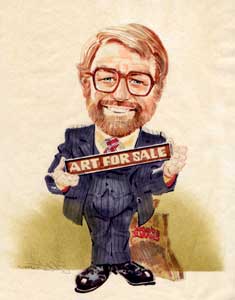
Caricature of Al Hedrick
Caricature of Al Hedrick drawn by Don Elstrom
Al says that most salespeople are either good at new sales or at recurring accounts, but he’s good at both. We are blessed to have him with us here at Discover, keeping the sales machine running. 🙂
Contact Al Hedrick at alhedrick@discovervintage.com.
The Kansas City Press Club years…
by Patti Klinge
Annual KC Press Club contest
In 2014, Bruce suggested that we submit an entry to the annual KC Press Club contest, where peers in another market judge publications in various categories. We won a silver award that year and at least one award each subsequent year that we entered the contest. In 2017 we hit the Motherload, taking two silvers and a gold award in our “Business-to-Business” category.
Best Part
The best part was that I was reacquainted with Corbin Crable, who was on the board at the time. Eventually, I was asked to join the board for a year and met some great folks who were passionate about supporting print publications.
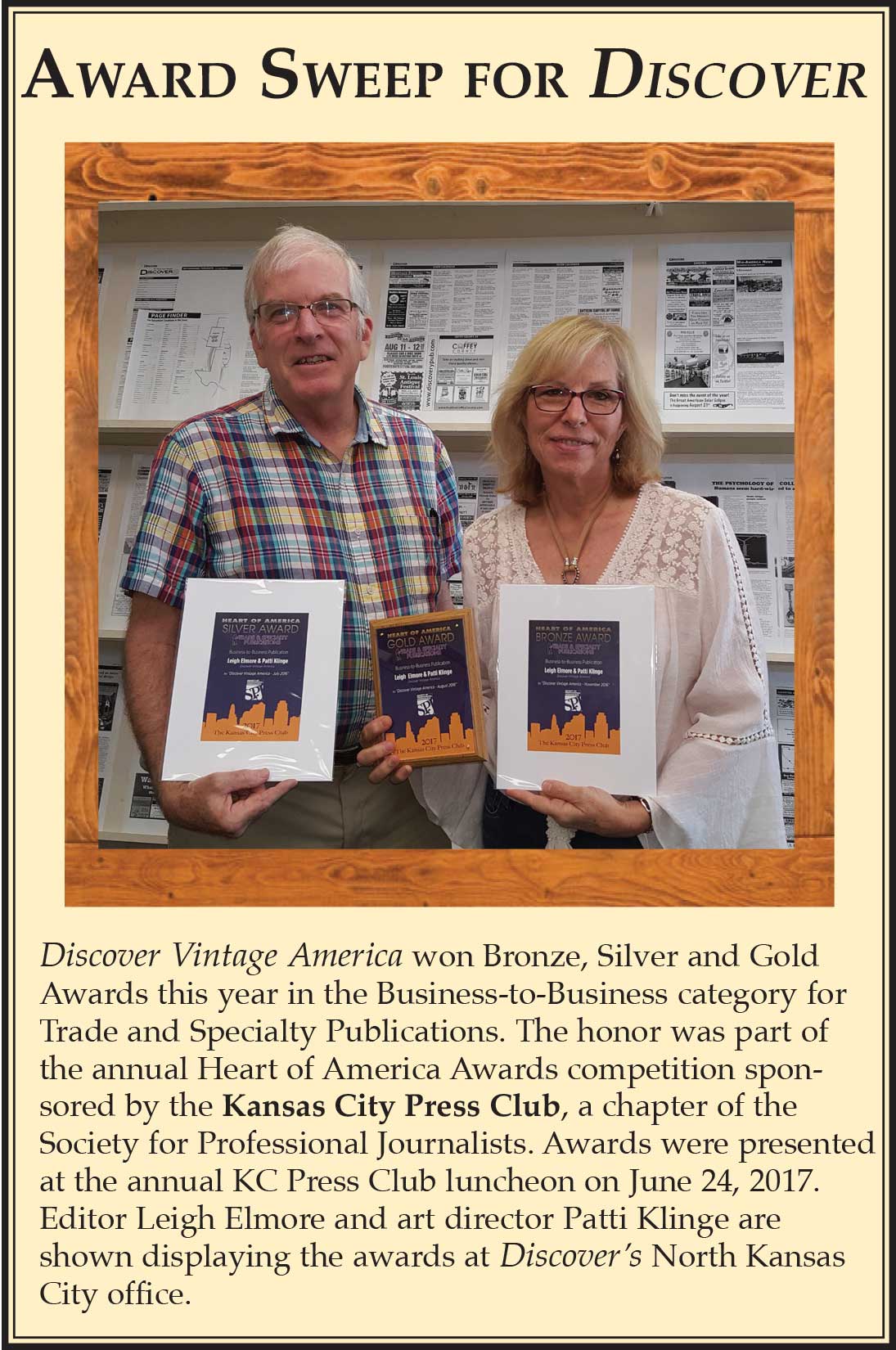
Leigh Elmore and Patti Klinge proudly hold the awards
Leigh Elmore and Patti Klinge proudly hold the awards presented by the Kansas City Press Club to DVA in 2017.
Newspaper publishing evolved from ‘cut and paste’
to computers
by Ken Weyand
The massive changes in the way we communicate are especially obvious to those of us who are in our “retirement years,” and notice (with dismay) the decline of metro dailies and much of print journalism in general.
“Old hands” also remember when producing a shopper or “neighborhood weekly” involved a crew of “paste-up artists” armed with “X-acto” knives and plastic “burnishers.” After the type had been keyboarded, a cartridge would be removed from a processor and taken to a darkroom, where rolls of photo paper would emerge to be waxed, cut into smaller pieces, and applied to light-weight card stock. These “paste-up boards” would be ruled in lines of non-reproducing blue, making it easier to assemble the ads and editorial copy.
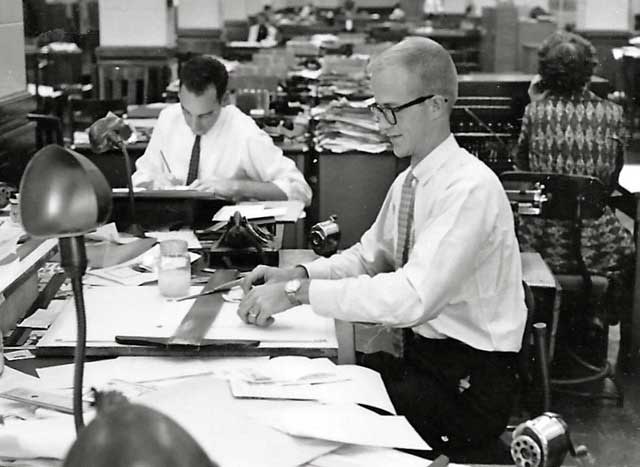
Creating newspaper content by hand
Much could go wrong in the process. I recall a hot day in August when I had picked up a box of paste-up boards to take to a printer. My car had been parked in the sun, with an interior temperature well above 100 degrees. By the time I reached the printers’ offices and opened the box, the wax that once secured everything had melted, and the once-burnished ads and editorial items looked like hundreds of curled-up potato chips.
After an hour or so of careful burnishing (with my heart in my mouth) I managed to salvage the mess, while the printer, well over his deadline, paced the floor. All would be well until the next issue when new challenges were sure to arise.
At least one trip to the printer involved leaving the box atop my car as I fumbled with keys and other things. Luckily I had barely started when I discovered the problem. The box fell off the car and some of the boards scattered on the asphalt. Fortunately, the day was cooler, and I was able to gather everything up and be on my way.
One thing that hasn’t changed is the dedication that goes into the process. With few exceptions, everyone in the “biz” today is making sacrifices to make things work. Most of those who put smaller publications together – including this one – wear many hats with minimum compensation. It’s a complicated process involving late hours, combining technical expertise with meeting the needs of advertisers and readers.
To me, watching it come together is as gratifying and magical as it was in 1973.
Ken Weyand is the original owner/publisher of Discover Vintage America, founded in July 1973 under the name Discover North.


